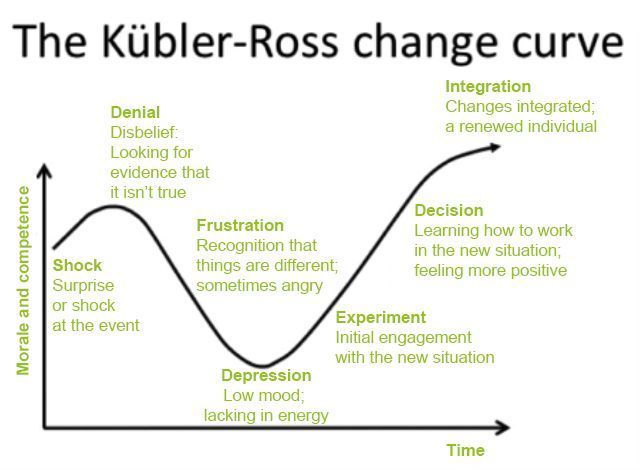Last month, you learned about the award-winning change management project I ran recently together with my associates. This month, you’ll discover how you can apply our unique six-stage methodology to your own change programme, with its focus on yourself and others (know yourself and know/support others).
Note that it’s important to accomplish each phase before you move on to the next, as each step builds on the previous one – if you skip or skim over a phase it’ll come back and bite you!
1. Purpose
Define the purpose you are trying to achieve with your change programme or business transformation, and help your stakeholders link it to their own personal purpose, values and aspirations. This is because people that are personally connected to your project are more likely to be engaged with it.
A useful analogy is that of an elephant and rider.
The rider is the rational part, that logically understands why the change needs to take place. But it won’t be a success unless your people are on board with you emotionally (the elephant) – emotions will always have a two-tonne advantage over the rational part.
Through powerful communication, connection and relationships, you can connect the elephant and rider, so both will be in tune with the purpose of your change.
Toolkit
It’s important to understand yourself, and your values, drivers, mindset and beliefs, as well as those of your people. To do this, you can run a values exercise.
It’s also helpful to be able to explain succinctly what the purpose of the change is. Take no more than two minutes, focusing on the benefits for the organisation and its higher purpose, as well as linking it (authentically) to the motivations of the individuals you are talking to.
Useful reading
- How your mindset can enable or limit you
- Start with why: How great leaders inspire everyone to take action
2. Diagnosis
To help you prepare to create your change plan, do a gap analysis to identify the size and complexity of your change challenge.
You probably already do this at task level in your organisation, but remember that a big change project will only work if you take your people along with you.
Toolkit
A heat map exercise will identify who your stakeholders are and their level of engagement. It helps you to surface some of the levers that will help or hinder the achievement of your change. Are they waiting to sabotage your project? Or are they powerful advocates?
Make sure you’ve got enough stakeholders with enough clout who really want the change to work.
if you have good, trusting relationships with your stakeholders, you could complete this exercise with them, and ask them what would enable them to be advocates for what you are trying to achieve – that way aiming for a win:win.
You can also do a forcefield analysis and use a change-readiness assessment tool.
3. Planning
The bigger the transformation that you want to achieve, the more strategic you’ll need to be in the plan you create: it may be a multi-year timeframe. It’s therefore important to break it down into different streams or categories to help people see how everything connects and doing this visually helps simplify what will otherwise look very complicated. These streams will be bespoke to your project but are always likely to include:
- People
- Process
- Systems
- “Business as usual” policies – incorporating this helps manage and pace workload during heavy periods
To ensure your stakeholders are aligned with you, work alongside them to put your change plan together. There will be different deadlines at different times, so put them into a good sequential order. Include major milestones, metrics and measures of success.
Toolkit
A transformation map will help you prioritise and visualise the plan. You can even make it into a wall poster so people can see what happens when. Note that this is not the same as a GANNT chart that makes most people’s eyes glaze over!
4. Prepare people
If change is forced through, it will fizzle out as soon as the next initiative rolls around the corner (and that’s if you get that far!).
Often, preparing people is an afterthought rather than integral to the whole change effort. But this is a very important phase that is unique to our change framework, and it’s important to ensure people are prepared before you move to implementation.
People go through change at different speeds. You can help them to recognise where they are, and what would enable them to get to the next stage: see below for the classic Change Curve to help identify where you are and to support your team members to move through these different stages.

It’s essential to understand the emotions that people are going through, and what they are afraid of – making the time to have these conversations will really pay off, so investing the time now will speed up and smooth out the implementation phase.
Many people fundamentally dislike change, ambiguity, and moving out of their comfort zone. When someone feels a social threat due to changes in their work, colleagues or status, the part of the brain that’s responsible for fight or flight kicks in (see the SCARF model below).
You as a leader can then take action to create a safe environment that helps people to experiment with the new.
Toolkit
The SCARF model (Status, Certainty, Autonomy, Relatedness, Fairness) is a useful way of understanding people’s emotions.
Also at this stage, it’s important to have good listening skills and ‘crucial conversations‘ where you both listen to the other person’s perspective, and advocate your own. Teaching this process to employees gives them a structure to “speak up”.
Useful reading
- How (and why) to collaborate effectively
- Why it’s OK to show emotion in the workplace
- Psychological safety and team effectiveness
- How to have courageous conversations
- Dealing with ambiguity
5. Implement and learn
Once your people are completely on board, you can start to implement the plan you’ve made. This is when the ‘rubber hits the road’.
As the leader, it’s important that you track your metrics and milestones, and celebrate early wins, no matter how small they seem.
We deliberately called this phase ‘implement and LEARN’. Inevitably, you’ll implement some changes that don’t work as well as you hoped. This is OK so long as you discuss and adapt. It’s also important to communicate your successes as much as possible and continue to focus on creating a safe environment for people to experiment with the new.
Toolkit
Spending time on what IS working is more motivating than focusing on problems. Model an Appreciative Inquiry (AI) approach, where you find pockets that work and spread the learning across the organisation.
(As you may remember from last month’s article, AI is one of the underlying philosophies behind the project.)
Useful reading
6. Sustain
It takes so much energy to get to this point, and it’s important to build in some thoughts about how to sustain it. Otherwise, the changes could quickly unravel, especially if/when the project’s main sponsor moves on.
The good news is that if people believe it’s the right thing to do and they see others adopting the change, it’s more likely to be sustained. So keep focusing on showing the metrics and success stories of stakeholders.
Toolkit
Explore how well previous change efforts have been sustained at your company, and identify the common themes and patterns (these will be different in every company’s culture).
Make sure they are embedded in your core processes including objective setting and performance reviews. They should be integrated, not just add-ons.
Useful reading
(Leadership Agility is another of the project’s underlying philosophies.)
The Business Transformation Network has posted this article in partnership with The Padfield Partnership.


